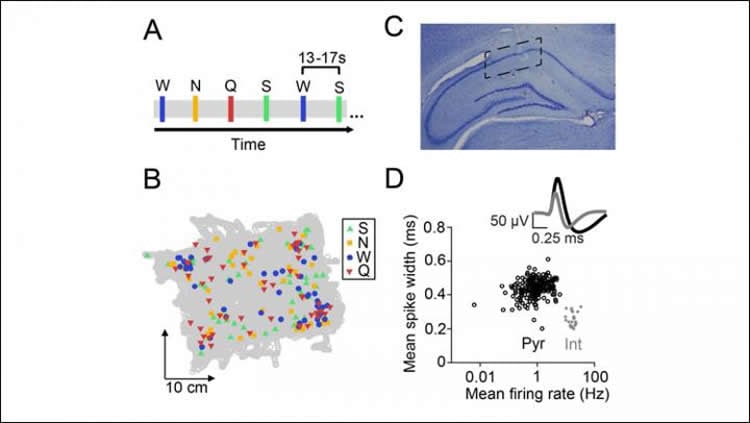Summary: Study reveals the hippocampus may overlay existing mental maps with information about reward and hazard derived from food found in specific locations.
Source: SfN.
A subset of neurons in the hippocampus respond to both place and taste, according to research in male rats published in Journal of Neuroscience. The study shows how animals may remember and find their way back to locations where they previously found nourishment.
Although the hippocampus is connected to parts of the brain’s taste system and active during taste discrimination tasks, its role in taste-processing has remained a mystery.
Shantanu Jadhav and Donald Katz, with graduate student Linnea Herzog and colleagues, randomly delivered four different tastes (sweet, salty, neutral, and bitter) to rats as they explored their environment. Recordings of individual hippocampal neurons revealed that about 20 percent of these cells were responsive to the palatability of taste stimuli. Of these, place cells responded to taste only in the location where the taste was delivered.

These results suggest the hippocampus overlays existing mental maps with information about the reward and hazard derived from food found in particular locations.
Funding: Alfred P. Sloan Foundation, Whitehall Foundation, NIH/National Institute on Deafness and Other Communication Disorders, NIH/National Institute on Drug Abuse funded this study.
Source: David Barnstone – SfN
Publisher: Organized by NeuroscienceNews.com.
Image Source: NeuroscienceNews.com image is credited to Herzog et al., JNeurosci (2019).
Original Research: Abstract for “Interaction of taste and place coding in the hippocampus” by Linnea E. Herzog, Leila May Pascual, Seneca J. Scott, Elon R. Mathieson, Donald B. Katz and Shantanu P. Jadhav in Journal of Neuroscience. Published February 18 2019.
doi:10.1523/JNEUROSCI.2478-18.2019
[cbtabs][cbtab title=”MLA”]SfN”How Animals Remember and Find Their Way Back to Food Sources.” NeuroscienceNews. NeuroscienceNews, 18 February 2019.
<https://neurosciencenews.com/animal-food-memory-10760/>.[/cbtab][cbtab title=”APA”]SfN(2019, February 18). How Animals Remember and Find Their Way Back to Food Sources. NeuroscienceNews. Retrieved February 18, 2019 from https://neurosciencenews.com/animal-food-memory-10760/[/cbtab][cbtab title=”Chicago”]SfN”How Animals Remember and Find Their Way Back to Food Sources.” https://neurosciencenews.com/animal-food-memory-10760/ (accessed February 18, 2019).[/cbtab][/cbtabs]
Abstract
Interaction of taste and place coding in the hippocampus
An animal’s survival depends on finding food, and the memory of food and contexts are often linked. Given that the hippocampus is required for spatial and contextual memory, it is reasonable to expect related coding of space and food stimuli in hippocampal neurons. However, relatively little is known about how the hippocampus responds to tastes, the most central sensory property of food. In this study, we examined the taste-evoked responses and spatial firing properties of single units in the dorsal CA1 hippocampal region as male rats received a battery of taste stimuli differing in both chemical composition and palatability within a specific spatial context. We identified a subset of hippocampal neurons that responded to tastes, some of which were place cells. These taste and place responses had a distinct interaction: taste-responsive cells tended to have less spatially specific firing fields, and place cells only responded to tastes delivered inside their place field. Like neurons in the amygdala and lateral hypothalamus, hippocampal neurons discriminated between tastes predominantly on the basis of palatability, with taste-selectivity emerging concurrently with palatability-relatedness; these responses did not reflect movement or arousal. However, hippocampal taste responses emerged several hundred msec later than responses in other parts of the taste system, suggesting that the hippocampus does not influence real-time taste decisions, instead associating the hedonic value of tastes with a particular context. This incorporation of taste responses into existing hippocampal maps could be one way that animals use past experience to locate food sources.
SIGNIFICANCE STATEMENT
Finding food is essential for animals’ survival, and taste and context memory are often linked. While hippocampal responses to space and contexts have been well characterized, little is known about how the hippocampus responds to tastes. Here, we identified a subset of hippocampal neurons that discriminated between tastes based on palatability. Cells with stronger taste responses typically had weaker spatial responses, and taste responses were confined to place cells’ firing fields. Hippocampal taste responses emerged later than in other parts of the taste system, suggesting that the hippocampus does not influence taste decisions, but rather, associates the hedonic value of tastes consumed within a particular context. This could be one way that animals use past experience to locate food sources.






